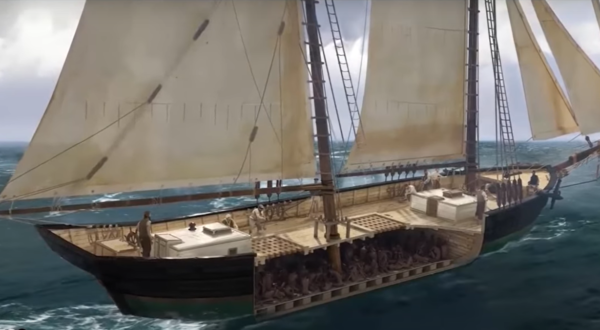A slave ship discovered near Mobile, Alabama in 2019 is mostly intact and could contain a wealth of historical artifacts, food and human DNA.
The 160-year-old wreckage of the Clotilda still contains the pen used to imprison Africans during the journey across the Atlantic Ocean in 1860. The wooden schooner, America’s last slave ship, crossed the ocean 50 years after it became illegal to import enslaved people to the U.S.

The ship’s captain burned the vessel to try and cover up evidence of the act, although most of it survived.
Archeologists have studied the wooden ship since it was identified in 2019 in the waters of the Mobile River. The vessel has been added to the National Register of Historic Places.
Researchers are learning that the ship is even more well-preserved than previously thought. It’s difficult to get a good luck at the ship underneath the muddy waters, but archeologists are using to sonar to examine it.
“This is the most intact slave ship known to exist in the archeological record anywhere,” Jim Delgado, a maritime archaeologist leading research into the ship, told National Geographic for an article published Dec. 21.
He estimates about two thirds of the wooden structure has survived.
“There’s actual direct physical evidence not just of the ship and its use, but also of the changes done by Foster and his crew to make it a slave ship,” Delgado said. “We can say what the size is of the area where people were held, and that was a very sobering and emotionally powerful moment for the team to see.”
Researchers plan to excavate part of the ship in March. There’s a possibility that supplies, barrels of pork and rice and human DNA from bodily fluids could be recovered from the vessel.
During the excavation, researchers will also examine the aquatic life colonizing the ship, take wood samples and determine whether or not it can be removed from the water without damaging its structure and contents.
Determining whether or not the ship could ever be raised or put on display will require lots of time and money, Delgado told The Associated Press.
“Generally, raising is a very expensive proposition. My sense is that while it has survived, it is more fragile than people think,” said Delgado. “A recovery could be a very delicate operation and also a very expensive and lengthy process.”
Alabama has set aside about $1 million for the research and preservation of the ship.
More stories from our partners:
‘It’s On Life Support’: Last Black-Owned Bank In Chicago Struggles to Remain Open


